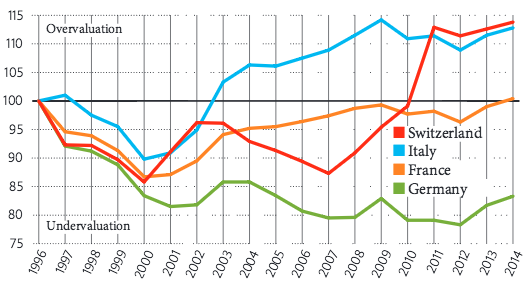The European Central Bank plans further quantitative easing. And Switzerland suffers: as a study shows, the Swiss economy is suffering the most from currency moves, particularly with regard to Germany as its most important trading partner, writes finance expert Albert Steck for finews.first.
This feature appears in our section finews.first. It is a forum for renowned authors specialized on economic and financial topics. The texts will be published both in German and English. The contributions appear in cooperation with Pictet, the Geneva-based private bank. The publishers of finews.ch are responsible for the selection. Previous contributions: Rudi Bogni, Adriano B. Lucatelli, Peter Kurer, Oliver Berger, Rolf Banz, Dieter Ruloff, Samuel Gerber, Werner Vogt, Claude Baumann and Walter Wittmann.
«La Suisse n’existe pas – Switzerland does not exist». That was Switzerland's provocative slogan at the 1992 World Exposition in Seville. But what do we find if we ask if the European currency exists?
My answer: «The euro does not exist» – to date, the euro has never been a homogeneous currency area. Instead, the economies of the Eurozone countries are drifting further and further apart.
This growing inequality is shown in the graphic below. The curves show how cheap or expensive it is to produce in a given country. Let's start with the so-called real effective exchange rate for Italy, the rate for the «Italian euro». As we see, this has become steadily more expensive since 2000, because Italian unit wage costs have risen faster than average.
Earlier, in the days of the lira, Italy would have been able to devalue its own currency in order to reverse this trend and help exporters regain competitiveness. Now, this is no longer possible in the Eurozone.
Expensive Switzerland, Cheap Germany

The real effective exchange rate of individual countries, based on their unit wage costs. This measures labour costs in relation to economic output (Data: Eurostat).
In Germany, the situation is reversed: as the graphic shows, the «German euro» is much too cheap. Since the abolition of the «hard» deutsche mark, there is no mechanism here either to correct this imbalance. However, for German exporters the undervaluation is an enormous advantage, as they can sell their goods at lower prices. The «French euro» meanwhile is currently fairly valued.
«Germany's currency advantage is around 25 percent»
So what's the status of the real effective exchange rate for Switzerland? As the graphic shows, the financial crisis led to a strong appreciation of the Swiss franc, because our country was in demand as a safe haven. This doesn’t leave Swiss exporters at any disadvantage compared to Italy, as Italian industry is also suffering from the overpriced «Italian euro».
However, this worsens the handicap compared to our German competitors, who are benefiting from the weak «German euro». Germany's currency advantage is around 25 percent.
The fact that Germany is also our most important trading partner makes this all the more serious for the Swiss economy. Over 40 percent of exports to the EU go to our northern neighbour, while France as the second most important country for exports has a share of only 15 percent.
The currency disadvantage compared to French companies is also «only» around 10 percent. Swiss exporters can try to lower the real effective exchange rate of the Swiss franc to the level of the «French euro» by steadily raising productivity (which lowers unit wage costs), but they cannot possibly close the huge gap with Germany simply by being more efficient.
«The greatest beneficiary of the weak euro is still the German export sector»
Meanwhile, the downtrend in the Eurozone is continuing, and the European Central Bank (ECB) will probably loosen its monetary policy even more on 10 March 2016. While this will temporarily ease the euro-frustration in countries such as Italy, Spain or France, the ECB cannot correct the gaping inequality in the Eurozone.
This is because the greatest beneficiary of the weak euro is still the German export sector, as reflected in last year's record export surplus of 250 billion euros. For comparison, the surplus was just 60 billion euros in 2000.
«Even in the USA there are growing complaints about the excessively cheap German euro»
As a result, the currency union is become an increasing source of discord, as countries compete on increasingly unequal terms – and not only within Europe. Even in the USA there are growing complaints about the excessively cheap «German euro», despite the relatively small share of trade between the two countries.
The U.S. bank J.P. Morgan has also studied how far the Eurozone can be defined as a homogeneous currency area, using a hundred socioeconomic criteria to measure inequalities within the zone.
The result was compared with a theoretical currency union consisting of all the countries in the world whose name begins with M. The sobering result is that the differences are smaller in the random collection of countries beginning with M than in the Eurozone. «L’euro n’existe pas – vive la différence.»
Albert Steck has worked for Migros Bank since 2007. He is responsible for market- and product analysis. He is also a finance columnist for the «Migros-Magazine» and a Blogger. After his studies in Economics, Political Science and Media he worked as a journalist, amongst others for the bi-monthly Swiss magazine «Bilanz». In 2007 he won the prestigious media prize for finance journalists in Switzerland.


































